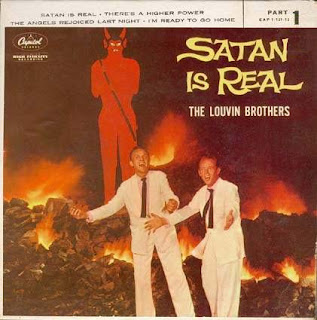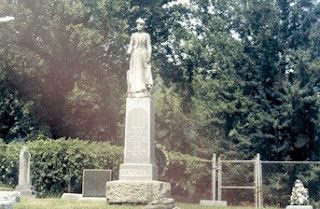
A great site for keeping up with the zombie threat in your area.
http://www.zombieforecast.org/
Paranormal investigating sisters on a quest to capture proof of the supernatural, to make you aware of movies that are strange and macabre. We scour the Web to find a glimpse into the dark realm, searching hundreds of links so you don't have to.
















Madison Cawein began hearing rumors about the blue people when he went to work at the University of Kentucky's Lexington medical clinic in 1960. "I'm a hematologist, so something like that perks up my ears," Cawein says, sipping on whiskey sours and letting his mind slip back to the summer he spent "tromping around the hills looking for blue people."Okay - that is only a slice of the article - - - you should really read the entire bit, frankly - it'll be well worth your time. When you've reached the end you'll understand why, even with diligent searches of the internet, you're unlikely to find many pictures of blue men or women, Kentuckian or otherwise - because those people affected with this genetic anomaly (I won't call it a defect or even a handicap, because I haven't read of any disabling physiological effects) fear, quite logically, that society would drag them out for public exposition. It is sad, really - a physical trait that could add to someone's uniqueness has had to be hidden out of fear that it will be exploited by the foulest pimps of the entertainment and yellow journalism - both printed and video tabloids. Indeed, I find it interesting that most of those folks interacting with the blue Fugates blame the geography of east Kentucky alone for their genetic inbreeding - I can't remember that any of them make the connection between their hesitancy to leave their family connections and the fact that these people, rational beings all, knew how they would be insulted, feared, abused, and most likely, very, very lonely. Ah well.
Cawein is no stranger to eccentricities of the body. He helped isolate an antidote for cholera, and he did some of the early work on L-dopa, the drug for Parkinson's disease. But his first love, which he developed as an Army medical technician in World War II, was hematology. "Blood cells always looked so beautiful to me," he says.
Cawein would drive back and forth between Lexington and Hazard an eight-hour ordeal before the tollway was built and scour the hills looking for the blue people he'd heard rumors about. The American Heart Association had a clinic in Hazard, and it was there that Cawein met "a great big nurse" who offered to help.
Her name was Ruth Pendergrass, and she had been trying to stir up medical interest in the blue people ever since a dark blue woman walked into the county health department one bitterly cold afternoon and asked for a blood test.
"She had been out in the cold and she was just blue!" recalls Pendergrass, who is now 69 and retired from nursing. "Her face and her fingernails were almost indigo blue. It like to scared me to death! She looked like she was having a heart attack. I just knew that patient was going to die right there in the health department, but she wasn't a'tall alarmed. She told me that her family was the blue Combses who lived up on Ball Creek. She was a sister to one of the Fugate women." About this same time, another of the blue Combses, named Luke, had taken his sick wife up to the clinic at Lexington. One look at Luke was enough to "get those doctors down here in a hurry," says Pendergrass, who joined Cawein to look for more blue people.
Trudging up and down the hollows, fending off "the two mean dogs that everyone had in their front yard," the doctor and the nurse would spot someone at the top of a hill who looked blue and take off in wild pursuit. By the time they'd get to the top, the person would be gone. Finally, one day when the frustrated doctor was idling inside the Hazard clinic, Patrick and Rachel Ritchie walked in.
"They were bluer'n hell," Cawein says. "Well, as you can imagine, I really examined them. After concluding that there was no evidence of heart disease, I said 'Aha!' I started asking them questions: 'Do you have any relatives who are blue?' then I sat down and we began to chart the family."
Cawein remembers the pain that showed on the Ritchie brother's and sister's faces. "They were really embarrassed about being blue," he said. "Patrick was all hunched down in the hall. Rachel was leaning against the wall. They wouldn't come into the waiting room. You could tell how much it bothered them to be blue."
After ruling out heart and lung diseases, the doctor suspected methemoglobinemia, a rare hereditary blood disorder that results from excess levels of methemoglobin in the blood. Methemoglobin which is blue, is a nonfunctional form of the red hemoglobin that carries oxygen. It is the color of oxygen-depleted blood seen in the blue veins just below the skin.

The Pope Lick Monster is a mythical creature said to live beneath the Pope Lick Trestle in Louisville, Kentucky. The Pope Lick Trestle is a long, high, and dangerous railroad trestle over Pope Lick Creek in Metro Louisville. Descriptions of the Pope Lick Monster vary; some describe it as having the body of a man and the head of a goat (a goatman), while others describe a white-haired, Yeti-like creature.
The behavior of the Pope Lick Monster includes driving people from its territory by wailing, screaming, or throwing stones. The Pope Lick Monster has also been blamed for the mutilation of sheep. The legendary monster has turned the trestle into a site for teenage legend trips. In 2000, a young man of nineteen years fell to his death from the trestle while attempting to cross it on foot; he may have been on a legend trip looking for signs of the monster [1].
The monster was the subject of a 1988 film by Ron Schildknecht, called The Legend of the Pope Lick Monster. Named for the creek outside of Louisville that the monster is said to haunt, the Pope Lick Monster appears as something of a hybrid between man and goat. Like the satyr of Greek mythology, the Pope Lick Monster carries itself on powerful goat-legs, although it is covered in albino fur. The upper body is the grostesquely deformed torso of a man. The skin is alabaster, except in places where the flesh is tight over bone, which show black through the ghostly skin. The face resembles that of a human, but it is clearly not: the black eyes are too far apart, the nose too aquiline, and the thick jaw sticks out too far. Short but sharp horns protrude from its forehead, just below the hairline. The hair atop the head is long, greasy, and matted, matching the fur on its legs.
The monster stalks a small creek and the train trestle that runs over it. The monster will mimic the voice of loved ones to lure victims onto the tressel, just as a train approaches. The victim becomes trapped on the tracks, forced to either be run down by the train, or plummet a hundred feet into the creek below. The monster will harass hikers or young couples parked at a nearby lover’s lane, hurling stones or making disturbing noises. The monster will rarely attack victims; when it does, it attacks with a rusted, blood-stained axe or kicking with sharp-hooves. The monster prefers tormenting any who comes in its domain, getting a sadistic pleasure in the terror of others.
The origin of the Pope Lick Monster is unknown. There are rumors it was birthed from the unnatural union of a farmer and his goat. One story says the monster was freak in a circus sideshow that passed through the Pope Lick area, during the early 20th century. The locals were very cruel to the goatman. When he escaped during a destructive thunderstorm, he pledged to revisit the locals cruelty upon them ten-fold.
Creatures very similar to the Pope Lick Monster are said to exist in Texas, Oklahoma, and Maryland.
I do not believe in the validity of this myth due to the fact that if he was real my sister would have dated him....Love Juni

Undulata was the setting for the Halloween party put on by Aunt Allison for the children of Lloydsborough Valley in “The Little Colonel’s Holidays” In Chapter XI, Annie Fellows Johnston provides the following description of the home that became known as “the haunted house of Hartwell Hollow” to millions of her young fans:
From The Little Colonel's Holidays (Chapter 11):
NOTHING worse than rats and spiders haunted the old house of Hartwell Hollow, but set far back from the road in a tangle of vines and cedars, it looked lonely and neglected enough to give rise to almost any report. The long unused road, winding among the rockeries from gate to house, was hidden by a rank growth of grass and mullein. From one of the trees beside it an aged grape-vine swung down its long snaky limbs, as if a bunch of giant serpents had been caught up in a writhing mass and left to dangle from tree-top to earth. Cobwebs veiled the windows, and dead leaves had drifted across the porches until they lay knee-keep in some of the corners.As Miss Allison paused in front of the doorstep with the keys, a snake glided across her path and disappeared in one of the tangled rockeries. Both the coloured women who were with her jumped back, and one screamed.
"It won't hurt you, Sylvia," said Miss Allison, laughingly. "An old poet who owned this place when I was a child made pets of all the snakes, and even brought some up from the woods as he did the wild flowers. That is a perfectly harmless kind."
"Maybe so, honey," said old Sylvia, with a wag of her turbaned head, "but I 'spise 'em all, I sho'ly do. It's a bad sign to meet up wid one right on de do'step. If it wasn't fo' you, Miss Allison, I wouldn't put foot in such a house. An' I tell you p'intedly, what I says is gospel truth, if I ketch sound of a han't, so much as even a rustlin' on de flo', ole Sylvia gwine out'n a windah fo' you kin say scat!
We know from a 1907 letter that real-life Little Colonel Hattie Cochran wrote to a fan in Shelbyville and now in the Filson Historical Society’s collection that the Haunted House of Hartwell Hollow was a real place in Pewee Valley. Annie Fellows Johnston’s 1929 autobiography “Land of the Little Colonel” also noted that, "The cabin where Gay spent a summer and the Haunted House of Hartwell Hollow had also burned to the ground." when she lamented the changes that had taken place in the valley since the time of the Little Colonel books.


